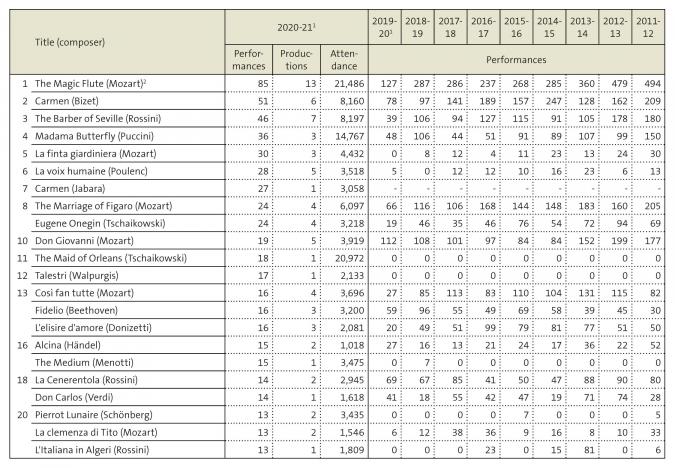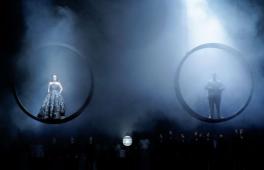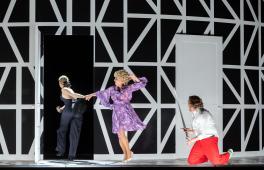The list of operas with the highest number of performances documents which works are particularly established in the repertoires of theatres in Germany. Rather, the 2020-21 season analysis must be viewed from a different perspective: it shows which works could have been performed at all for several times in front of an audience.
With 85 performances, ‘The Magic Flute’ by Wolfgang Amadeus Mozart tops the list of the most performed operas of the 2020-21 season. The 13 productions of the work that could have been performed in front of an audience in 2020-21 were attended around 21,500 times. Compared to the season data before the outbreak of the COVID-19 pandemic (2018-19), this represents a decline in the number of performances by 200 and a decrease in attendance by almost a quarter of a million. Engelbert Humperdinck's fairy tale opera ‘Hansel and Gretel’, which is usually one of the most performed and attended operas in Germany, has only been performed three times in 2020-21 season in front of a total of 756 opera goers – therefore it does not appear at all in this list.
Under these special season conditions, the ranking also includes works (some of them contemporary) that are less often or rarely performed on German stages, including Mozart's ‘La finta giardiniera’, ‘La voix humaine’ by Francis Poulenc, Tchaikovsky's ‘The Maid of Orleans’, ‘The Medium’ by Gian Carlo Menotti and ‘Pierrot Lunaire’ by Arnold Schönberg. In addition to the original version, the list also includes Marty Jabara's adaptation of Bizet's ‘Carmen’, which premiered in the 2020/21 season. For the first time, the work of a female composer appears in the ranking: ‘Talestri’, composed by Duchess Maria Antonia Walpurgis.

Note
The work statistics are drawn from a complete survey based on online questionnaires (written questionnaires until 2013-14) submitted to all state, municipal and regional theatres and major private theatres in the German-speaking countries. Also included are festivals with theatre productions and training institutions where productions reach public performance under professional supervision. The figures cover the theatre’s entire repertoire (own and co-productions), including concert performance and guest appearances at other theatres, but with no claim to completeness; guest appearances by outside ensembles at the theatre’s own premises are excluded. As many theatres report number of performances but not attendance, gaps in the presentation may occur.
The 2014-15 statistics were accompanied by a revision of the classification system to take into account the diversity of work manifestations in different theatre formats. Since then, the decisive factor is no longer a predefined classification of a work into the three main categories of musical theatre (opera, operetta, musical), drama and ballet/dance, but the decision of the theatres as to how a production positions itself as a work. For this purpose, the classification system was expanded: since 2014-15, children‘s and adolescent‘s theatre, puppet theatre, revue/Liederabend and multi-genre projects/performances have been listed on an equal footing with the main categories. Operas or opera adaptations that are assigned to these categories are not included in these statistics. This also applies to productions that fall under the category Digital Theatre, which has been introduced in the 2019-20 season and for which no performance figures are available. Digital theatre includes both genuinely digital productions and stage productions, which are streamed live or posted online as recordings.
Footnotes
-
Due to the COVID-19 pandemic since March 2020, theatre operations were restricted and venues have repeatedly been closed. This is reflected in the season‘s statistics.
-
Unlike previous editions of the statistics, beginning in the 2014-15 season only performances of original versions are taken into account. In consequence, the number of performances of Mozart’s Magic Flute has sharply declined compared to previous years, the reason being that it is frequently mounted in versions for children and adolescents or in other adaptations.
Source information
Compiled by the German Music Information Centre from various issues of Wer spielte was? Werkstatistik, published annually by the German Theatre and Orchestra Association (Deutscher Bühnenverein).









